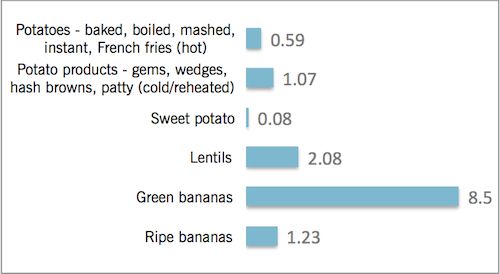Why’s there a debate in the first place?
In recent years, the sweet potato (but not the regular potato) has enjoyed “superfood” status among healthy eaters and regular exercisers.
Some researchers have suggested that potatoes might carry harmful anti-nutrients. Others that their glycemic index (GI) is too high. As a result, the humble spud has taken a mashing in the recent low-carb years.
But, here’s the thing. Both regular potatoes and sweet potatoes are healthy, awesome, and delicious heritage foods.
You can eat and enjoy both, regardless of your goals.
With that in mind, let’s dig up the truth about our tuberous friends.
Carbohydrate type: Starch or sugar?
Here’s how 100 grams (about a cupped handful) of raw regular potatoes and orange sweet potatoes compare in terms of calories, fiber, and macronutrient content.
| Potatoes | Sweet potatoes | |
|---|---|---|
| 1 medium sized, baked | 1 medium sized, baked | |
| Calories | 161 | 103 |
| Protein | 4.3 g | 2.3 g |
| Fat | 0 g | 0 g |
| Carbohydrates | 37 g | 24 g |
| Fiber | 3.8 g | 3.8 g |
Looks pretty similar. But let’s examine the carbohydrate type more closely.
| Potatoes | Sweet potatoes | |
|---|---|---|
| 1 medium sized, baked | 1 medium sized, baked | |
| Starch | 29.9 g | 8.0 g |
| Sugars | 2.0 g | 7.4 g |
|
Sucrose
|
692 mg | 2599 mg |
|
Glucose
|
761 mg | 650 mg |
|
Fructose
|
588 mg | 570 mg |
Source: Nutritiondata.self.com
As you can see above, sweet potatoes are indeed sweeter: They have almost 4 times the sugar content of regular potatoes. (However, if regular potatoes are stored in cold storage, over time their starch content slowly transforms into glucose and fructose.)
Resistant starch
Most tubers contain some resistant starch — complex starch molecules that we can’t digest, which are then broken down by our gut bacteria in our large intestine.
Compared to sweet potatoes, regular potatoes have more resistant starch.
Potatoes also have a type of resistant starch known as retrograde starch: When you cook and then cool potatoes, the starch molecules shuffle themselves around into a different structure.
(You might have noticed the same type of phenomenon if you’ve ever cooked a batch of oatmeal, refrigerated it, and noticed a jelly-like texture after it was chilled.)
You can see the difference that temperature makes in the chart below. We’ve added some cooked lentils and bananas for comparison.
To digest both potatoes and sweet potatoes, we have to break down and release the starch stored inside their cells.
Because some of that starch is resistant starch, this breakdown takes time and effort, so although both potatoes and sweet potatoes are high in carbs, they don’t act the same way in our body as high-carb processed foods.



